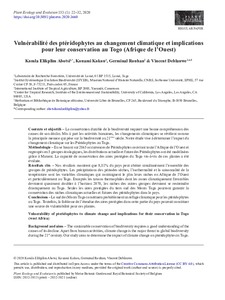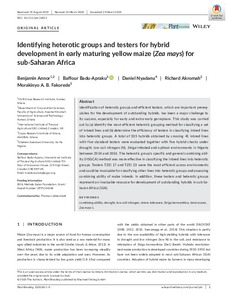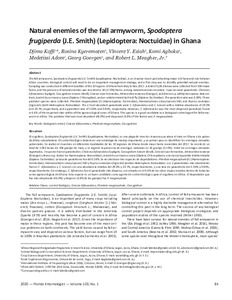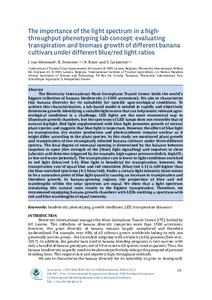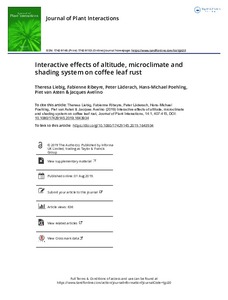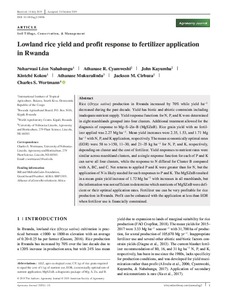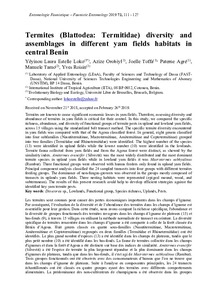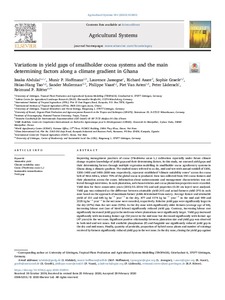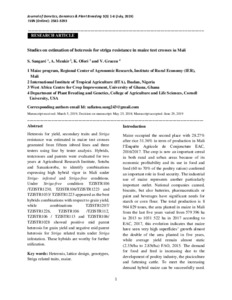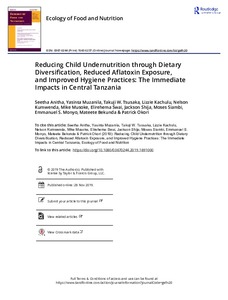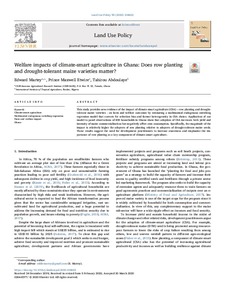Welcome to the International Institute of Tropical Agriculture Research Repository
Journal and Journal Articles: Recent submissions
Now showing items 1121-1140 of 5157
-
Vulnérabilité des ptéridophytes au changement climatique et implications pour leur conservation au Togo (Afrique de l’Ouest)
(2020-03-26)Contexte et objectifs – La conservation durable de la biodiversité requiert une bonne compréhension des causes de son déclin. Mis à part les activités humaines, les changements climatiques se révèlent comme la principale menace qui pèse sur la biodiversité au 21ème siècle. Notre étude vise à déterminer l’impact du changement climatique sur les Ptéridophytes au Togo. Méthodologie – En se basant sur 2865 occurrences de Ptéridophytes couvrant toute l’Afrique de l’Ouest et regroupés en 5 groupes ... -
Identifying heterotic groups and testers for hybrid development in early maturing yellow maize (Zea mays) for sub-Saharan Africa
(2020-04-20)Identification of heterotic groups and efficient testers, which are important prerequisites for the development of outstanding hybrids, has been a major challenge to its success, especially for early and extra‐early germplasm. This study was carried out to (a) identify the most efficient heterotic grouping method for classifying a set of inbred lines and (b) determine the efficiency of testers in classifying inbred lines into heterotic groups. A total of 205 hybrids obtained by crossing 41 inbred ... -
Gender and impact of climate change adaptation on soybean farmers' revenue in rural Togo, west Africa
(2020-04-01)This study assesses the impact of climate change (CC) adaptation on farm-level revenue among 500 soybean farmers randomly selected in three districts in Togo using endogenous switching regression method. The survey results indicate that only 40.37% of the women have adapted to CC against 59.62% of the men. Moreover, being member of farmer-based organization (FBO), access to credit and extension services, agricultural training of women are the main factors that increase the likelihood of adaptation. ... -
Distribution, prevalence, and severity of damages caused by nematodes on yam (Dioscorea Rotundata) in Nigeria
(2020-04-17)Nigeria is the main yam-growing country of the world. In the country, various plant-parasitic nematodes have been reported constraining yam production and the storability of tubers. This study established the damage level of nematodes on white yam tubers (Dioscorea rotundata) across the major production areas in the country for management purposes. Incidence and severity of symptoms (cracking, dry rot, and galling) associated with nematodes were assessed on 1,114 yam heaps (181 vendors) from 23 ... -
Natural enemies of the fall armyworm, Spodoptera frugiperda (J.E. Smith) (Lepidoptera: Noctuidae) in Ghana
(2020-04-08)The fall armyworm, Spodoptera frugiperda (J.E. Smith) (Lepidoptera: Noctuidae), is an invasive insect pest attacking maize in Ghana and sub-Saharan Africa countries. Biological control will need to be an important management strategy, and a first step was to identify potential natural enemies. Sampling was conducted in different localities of the 10 regions of Ghana from May to Nov 2017. A total of 1,062 larvae were collected from 106 maize farms, and the presence of natural enemies was recorded ... -
The importance of the light spectrum in a high-throughput phenotyping lab concept: evaluating transpiration and biomass growth of different banana cultivars under different blue/red light ratios
(2020-03)The Bioversity International Musa Germplasm Transit Center holds the world's biggest collection of banana biodiversity (>1500 accessions). We aim to characterize this banana diversity for its suitability for specific agro-ecological conditions. To achieve this characterization, a lab-based model is needed to rapidly and objectively determine growth. Identifying a suitable light source that can help mimic relevant agro-ecological conditions is a challenge. LED lights are the most economical way to ... -
Insects as feed: gendered knowledge attitudes and practices among poultry and pond fish farmers in Kenya
(2019)This qualitative study on knowledge, attitudes and practices (KAP) among poultry and pond fish farmers from Kisii, Nakuru and Kirinyaga counties in Kenya was conducted to establish insect for feed interventions likely to reduce the cost of feeds in these enterprises and benefit women and men equitably. Data were collected through sex and enterprise type disaggregated focus group discussions with farmers. Poultry farming was more established than fish farming in all three counties. Women were more ... -
Examining the sustainability and development challenge in agricultural-forest frontiers of the Amazon Basin through the eyes of locals
(2020)The Amazon basin is the world’s largest rainforest and the most biologically diverse place on Earth. Despite the critical importance of this region, Amazon forests continue inexorably to be degraded and deforested for various reasons, mainly a consequence of agricultural expansion. The development of novel policy strategies that provide balanced solutions, associating economic growth and environmental protection, is still challenging, largely because the perspective of those most affected- local ... -
Interactive effects of altitude, microclimate and shading system on coffee leaf rust
(2019)Shade effects on coffee diseases are ambiguous because they vary depending on the season and environment. Using Coffee Leaf Rust (CLR) as an example, we demonstrate relationships between the environment and shading systems and their effects on disease intensity. We characterized seasonal variations in microclimate and CLR incidence across different altitudes and shading systems, and integrated effects between the environment, shading systems, microclimate and CLR into a piecewise structural equation ... -
An integrated molecular and conventional breeding scheme for enhancing genetic gain in maize in Africa
(2019)Maize production in West and Central Africa (WCA) is constrained by a wide range of interacting stresses that keep productivity below potential yields. Among the many problems afflicting maize production in WCA, drought, foliar diseases, and parasitic weeds are the most critical. Several decades of efforts devoted to the genetic improvement of maize have resulted in remarkable genetic gain, leading to increased yields of maize on farmers’ fields. The revolution unfolding in the areas of genomics, ... -
Lowland rice yield and profit response to fertilizer application in Rwanda
(2019-12-10)Rice (Oryza sativa ) production in Rwanda increased by 70% while yield ha−1 decreased during the past decade. Yield has biotic and abiotic constraints including inadequate nutrient supply. Yield response functions for N, P, and K were determined in eight marshlands grouped into four clusters. Additional treatment allowed for the diagnosis of response to Mg–S–Zn–B (MgSZnB). Rice grain yield with no fertilizer applied was 2.27 Mg ha−1. Mean yield increases were 2.35, 1.53, and 1.71 Mg ha−1 with N, ... -
Termites (Blattodea: Termitidae) diversity and assemblages in different yam fields habitats in central Benin
(2019)Termites are known to cause significant economic losses in yam fields. Therefore, assessing diversity and abundance of termites in yam fields is critical for their control. In this study, we compared the specific richness, abundance, and diversity of functional groups of termite pests in upland and lowland yam fields, across 15 villages using the standardized belt transect method. The specific termite diversity encountered in yam fields was compared with that of the Agoua classified forest. In ... -
Managing phosphate rock to improve nutrient uptake, phosphorus use efficiency, and carrot yields
(2020-04-08)The objectives of this study were to assess (a) the efficiency of lemon and pineapple juices and the concentration and time needed to release more than 50% of available phosphorus from phosphate rock (PR), and (b) the effect of different types of PR management on carrot yields, nutrient uptake, and phosphorus use efficiency. Field trials were set up at two sites with humic andosols and orthic acrisols over two seasons in Kenya. In a randomized complete block design, replicated three times, the ... -
Variations in yield gaps of smallholder cocoa systems and the main determining factors along a climate gradient in Ghana
(2020)Improving management practices of cocoa (Theobroma cacao L.) cultivation especially under future climate change requires knowledge of yield gaps and their determining factors. In this study, we assessed yield gaps and their determining factors through multiple regression modelling in smallholder cocoa agroforestry systems in Ghana along a climatic gradient. The studied zones referred to as dry, mid and wet with annual rainfall of 1200, 1200–1400 and 1400–2000 mm respectively, represent established ... -
Cowpea (Vigna unguiculata (L.) Walp) for food security: an evaluation of end-user traits of improved varieties in Swaziland
(2019)Improved varieties have agronomic advantages over local varieties,but not much attention has been given to understand the nutritional content of the improved cowpea varieties released in Swaziland. This study investigated the physical and nutritional properties of improved cowpea varieties released in Swaziland. Five improved varieties (IT-04K-321-2, IT-97K-390-2, IT-18, IT-16, and IT-99K-494-6) and one local variety (Mtilane, as check) were analyzed for physical and chemical properties. The results ... -
Studies on estimation of heterosis for striga resistance in maize test crosses in Mali
(2019)Heterosis for yield, secondary traits and Striga resistance was estimated in maize test crosses generated from fifteen inbred lines and three testers using line by tester analysis. Hybrids, testcrosses and parents were evaluated for two years at Agricultural Research Institute, Sotuba and Sanankoroba, to identify combinations expressing high hybrid vigor in Mali under Striga- infested and Striga-free conditions. Under Striga-free condition TZISTR106/TZISTR1230, TZISTR106/TZISTR1223 and TZISTR1033/ ... -
Reducing child undernutrition through dietary diversification, reduced aflatoxin exposure, and improved hygiene practices: the immediate impacts in central Tanzania
(2019)The study aimed to quantify the immediate effects of dietary diversification, food safety, and hygiene interventions on child undernutrition in four rural villages in Kongwa district of central Tanzania. One hundred mothers with their children of less than 24 months old were recruited for this study. The difference-in-difference (DID) method was used to assess the effects of intensive intervention through a learning-by-doing process on the topic of aflatoxin free diversified food utilization and ... -
Welfare impacts of climate-smart agriculture in Ghana: does row planting and drought-tolerant maize varieties matter?
(2020-06)This study provides new evidence of the impact of climate-smart agriculture (CSA) – row planting and drought-tolerant maize varieties - on farm and welfare outcomes by estimating a multinomial endogenous switching regression model that corrects for selection bias and farmer heterogeneity in CSA choice. Application of our model to panel observations of 438 households in Ghana show that adoption of CSA increases both yield and intensity of maize commercialization but negatively affect own consumption. ... -
Cowpea (Vigna unguiculata (L.) Walp) for food security: an evaluation of end-user traits of improved varieties in Swaziland
(2019)Improved varieties have agronomic advantages over local varieties,but not much attention has been given to understand the nutritional content of the improved cowpea varieties released in Swaziland. This study investigated the physical and nutritional properties of improved cowpea varieties released in Swaziland. Five improved varieties (IT-04K-321-2, IT-97K-390-2, IT-18, IT-16, and IT-99K-494-6) and one local variety (Mtilane, as check) were analyzed for physical and chemical properties. The results ... -
Participation or legitimisation? Assessment of quality of participation in farmer learning video production in central Uganda
(2019)Purpose: This study assessed the quality of participation in farmer learning video (FLV) production by examining opportunities for actors’ participation and the extent of incorporation of their interests. Design/methodology/approach: A qualitative case study research design was used through focus group discussions and interviews held with 5 key informants and 19 farmers involved in the production of 2 videos. We used the quality of participation analytical framework for analysis. Findings: Actors ...

